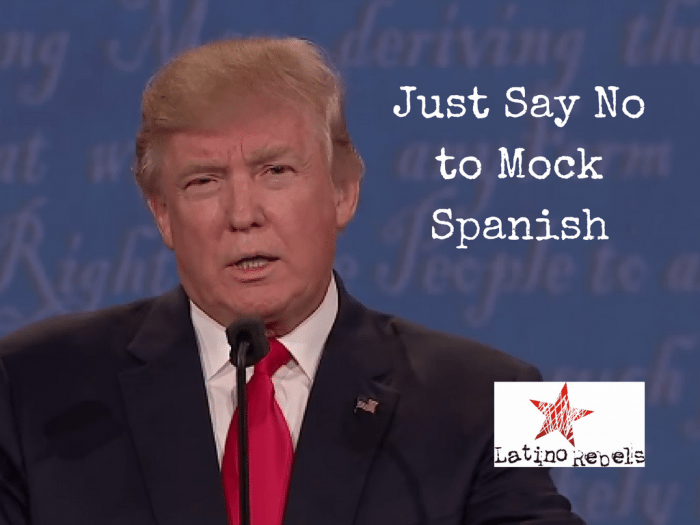“We have some bad hombres here and we’re going to get them out.”
Donald J. Trump, October 19, 2016
According to linguistic anthropologist Jane Hill (source), Mock Spanish starts from a key premise that white Americans in the U.S. Southwest do not necessarily “manifest some abstract zero degree of monolingualism. They do use Spanish, but in limited and specialized ways that support a broader project of social and economic domination of Spanish speakers in the region” (Hill, 1993: 147). While the context of Donald Trump’s identification as a white man isn’t limited to his relationship with the U.S. Southwest (or the borderlands that include states like California, Arizona, New Mexico or Texas), his use of that one word —hombres— was all about maintaining a larger racial order within the context of his perception of social disorder.
I’m a student and teacher of Spanish at heart. I’ve taught middle school and high school Spanish, and continue to teach that language (and about that language, and ways in which its speakers may identify as bi- and multilingual) here at Oregon State University. I’ve for some time now made efforts to teach about Mock Spanish in my basic-level Spanish classrooms, and of course, the classes I offer in subjects like linguistic anthropology (Hill’s disciplinary home base). Doing so can be exceptionally challenging, and I’ve come to expect pushback. The processes and strategies by which Mock Spanish “happens” are ordinary in their daily occurrence, but surprisingly complex in their discursive, rhetorical, if not psychological makeup. In my experience, to teach about Mock Spanish is to make an attempt to convince a largely white classroom (aligned with relatively standard varieties of “unaccented” English) that racism can exist in a sneaky, covert ways. Of course, these are ways that go unseen and undetected by Mock Spanish’s largely white users—which of course, undergirds the very definition of white privilege and white fragility.
To produce and rely on Mock Spanish within otherwise monolingual English speech (see Wednesday’s debate, for instance) is an often unconsciously strategic effort to silently dominate the folks who are imagined to speak that language, but to do so through attempts at silliness, humor and acting “cool” or “with it.” In other words, Mock Spanish is a great way by which white, largely monolingual English speakers “perform” Spanish for each other—in speech, in advertisements, through the artful design of Hallmark greeting cards. After all, there was an entire film (Terminator II) whose success largely rests on Arnold Schwarzenegger’s delivery of Mock Spanish punchline.
According to Hill’s work, Mock Spanish takes place through up to four key strategies. The first three include often sexualized euphemism (cojones), hyper-Anglicized speech (grassy-ass! or, for that matter, the pronunciation of hombres as ahm-brays) or pot-shots at Spanish syntax (no problem-o). And these are all means, all careful devices that clarify that a speaker is asserting control and dominance over the symbolic value of the Spanish language (and by extension, Latin@/x and Chican@/x voices to which that language is attached), but in a way that shall never be mistaken as ‘authentically’ Spanish. Finally, there is the Trumpian tactic of using an ordinarily positive or neutral word in Spanish to indicate meaning that is hardly positive or neutral (hombres).
And, let’s be clear about that last one: Trump did not say “bad men.” He said ‘bad HOMBRES.’ It was HOMBRES that connected the notion of “immigrant” not simply to “men” (the literal translation of that word), but to what the Spanish-ness of his choice could index: MEXICAN men as inherently undesirable, “illegal,” criminal, violent, and you know, all the other racist, anti-immigrant discourse he’s proudly associated himself with. The racism inherent in his choice of HOMBRES seems undeniable, indisputable and of course, unsurprising.
The context is clear. He is, after all, Trump. He’s undeniably responsible for making overt, in-your-face racism fashionable again.
In that clear context, it was HOMBRES —that one word— that lit up social media last night in the same way that Trump’s naming Hillary Clinton “a nasty woman” (shout out to Ms. Janet) blew the lid off any prior claim that nobody respects women more than he. And yet here it is, an example of Mock Spanish, delivered by the most contemporary embodiment of racist discourse. This was a token of Mock Spanish that in any other context might so be easily defensible as “just a clever use of Spanish,” “just a joke” or an inspiration for a quip like “I think we’re just too PC nowadays.”
The bottom line is this: I think Donald Trump just made it a hell of a lot easier for me —and for all of us who teach about language, race and racism— to talk with students about Mock Spanish and the power of covert racist discourse. Trump exemplified how Mock Spanish worked, for all its discursive complexity and its seemingly ordinary, daily usage. Hombre itself might not be a racial slur, but when Trump used it last night, and when the word itself turned into a symbolic representation of his racism —the scope of that word’s injury, its offensiveness, its oppressive potential— became crystal clear.
For more about Hill’s work, read The Everyday Language of White Racism.
***
ADAM SCHWARTZ, Ph.D. is an assistant professor in the School of Language, Culture & Society at Oregon State University (Corvallis), where he teaches courses in Spanish, Applied Linguistics, Linguistic Anthropology and Ethnic Studies. His research specializes in Spanish language education in the U.S. and U.S.-Mexico borderlands, and constructions of culture, borders, foreignness, race and privilege both in and outside classrooms.




[…] especialista en educación del idioma español de la Universidad Estatal de Oregón, dijo: libros Que “Donald Trump ha hecho que sea mucho más fácil para mí (y para todos los que estudian el […]